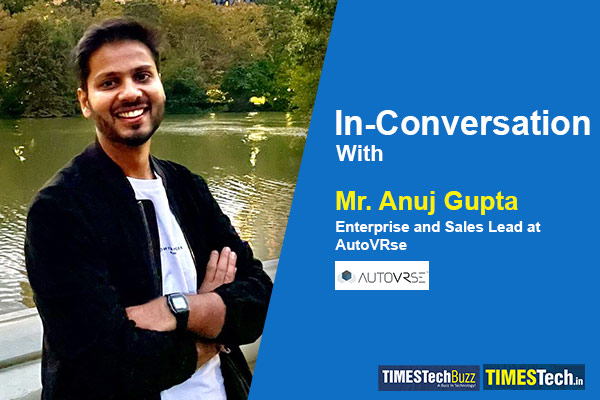In an exclusive interview with TimesTech, Mr. Anuj Gupta, Enterprise and Sales Lead at AutoVRse, sheds light on the groundbreaking AR/VR solutions revolutionizing industries. From collaborations with giants like Shell and Fidelity Investments to overcoming challenges in projects like UltraTech Cements, AutoVRse is setting new standards in immersive technology, aiming to lead globally in software and headset applications.
Read full interview here:
TimesTech: Can you share specific examples of AutoVRse’s innovative AR solutions for clients and how these solutions have positively impacted their operations?
Mr. Anuj: Working together with top manufacturers like John Deere and Ultratech, we developed Automated Sequenced Torquing and remote support, offering on-the-spot direction during critical manufacturing operations. Our collaborations with Ultratech, Tata, Shell, and Grasim in safety and process training have produced engaging training programs that improve worker skills and also promote a safer workplace. Customers like Shell, Birla Carbon, and Bosch are now able to market their products in a way that is immersive and captivating thanks to our Product Configurators. Furthermore, our Plant Walkthroughs, which we created for clients such as Godrej, Piramal, and Grasim, have proven useful for employee onboarding and client visits, providing comprehensive insights into end-to-end manufacturing processes.
TimesTech: How have collaborations with companies like Shell and Fidelity Investments contributed to AutoVRse’s development, and what insights have been gained through these industry-leading partnerships?
Mr. Anuj: Working with industry titans such as Shell and Fidelity Investments has given us a great deal of understanding of two very different industries. Through our collaboration with Shell, we investigated how immersive technologies might be integrated into the full oil industry, with a particular emphasis on marketing, safety, inspection, and training. However, since the primary uses of VR/AR in the financial sector were for employee onboarding and client acquisition, collaborating with Fidelity presented special difficulties. This contrast highlighted our technology’s varying potential and challenges in different domains. Notably, with both Shell and Fidelity being Fortune 500 companies with global operations, our initial projects in India paved the way for global recognition and subsequent collaborations. While working on these projects, we gained invaluable insights into managing and carrying out projects on an international scale and deepening our understanding of global markets. These partnerships have been crucial to AutoVRse’s growth, expanding our horizons and enhancing our ability to provide creative solutions for a variety of industries.
TimesTech: Can you elaborate on the challenges faced during the UltraTech Cements project and how AutoVRse’s VR training solution effectively addressed those challenges?
Mr. Anuj: We faced several challenges while working on our project with UltraTech. One significant barrier was employee behaviour, as there was initial resistance to embracing technology within India’s manufacturing plants. In order to get around this, we devised a plan that included employee competition, gamification, testing, and persuasive initiatives. This made the process of adopting VR training fun and interesting. Another difficulty was scaling, particularly when using the solution on several plants. To address this, we designated Safety Champions in each location—people who have been trained and nominated to spearhead the digitisation efforts in their plants. This guaranteed a seamless and effective scaling procedure. Managing training data became essential as the project grew. We streamlined this by introducing a Web Dashboard that corporate super admins and plant administrators could access, which allowed for easy tracking of data and analysis of progress for all users. The UltraTech Cements project is a successful example of how our VR training can overcome challenges and produce significant results.
TimesTech: How does AutoVRse plan to lead in software and headset applications globally, and what steps are being taken to set training standards on a global level using VR technology?
Mr. Anuj: One of our main goals is to move 3D design into the VR environment. Traditionally, external software is used for modeling and designing VR applications, necessitating additional optimization. By starting design from the ground up in VR, we hope to completely transform this process and produce outcomes that are quicker and more effective. In order to expedite the scripting process for VR experiences, we are also integrating AI and a no-code platform. One way to achieve this is by developing modular building blocks, which make it possible to construct a variety of experiences without requiring coding knowledge. Furthermore, we are at the forefront of a VR ideology that goes beyond the traditional understanding of reality replication. Rather than stopping at reality, we see VR evolving to a point where objects can interact and communicate with one another, improving the whole VR experience.
TimesTech: How does AutoVRse’s cross-platform VR training solution benefit both trainees and trainers, and can you share success stories from clients who have adopted this approach?
Mr. Anuj: With the addition of a multiplayer feature and device agnosticism, our cross-platform VR training solution has experienced a revolutionary evolution. This has produced a great deal of benefits for both trainers and trainees. One such example is Shell’s use of the multiplayer function in their reactor assembly project. Trainers and trainees can collaborate in VR from different locations, allowing for hands-on training. Instructors lead students through the assembly procedure and offer prompt feedback, fostering an engaging and productive learning environment. Tata AutoComp, on the other hand, uses the program differently. Trainers use desktops to assign assignments and design training activities for trainees. Following completion, the dashboard allows trainers to track progress and evaluate reports. In both cases, we want to give trainers confidence that users have mastered the necessary skills, whether they check in VR or not. This multi-platform approach has not only improved the training experience, but has also resulted in positive feedback and successful outcomes from our clients.
TimesTech: How do you see the impact of AR and VR evolving in the near future, and what trends do you anticipate in the immersive technology space, particularly for enterprise solutions?
Mr. Anuj: Looking ahead, I predict a sharp increase in manufacturing training applications, encompassing everything from maintenance to safety. This could lead to an interesting landscape of automated training modules that could be indefinite. Companies may choose to adopt widely accessible generic modules or create their own DIY modules. AI and machine learning will soon be a part of VR experiences; companies are already investigating how to turn current simulations into fully immersive VR environments. The demand for seamless IT integration and an extra layer of security is rising as these stand-alone solutions become more popular. Maintaining an advantage is not enough; we also need to reinvent our methods and realise the complete possibilities of immersive technologies in the business sphere. The future is truly filled with possibilities.















